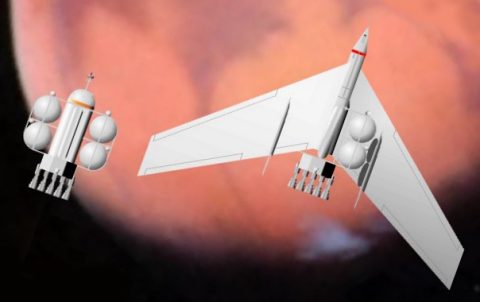
Home - Search - Browse - Alphabetic Index: 0- 1- 2- 3- 4- 5- 6- 7- 8- 9
A- B- C- D- E- F- G- H- I- J- K- L- M- N- O- P- Q- R- S- T- U- V- W- X- Y- Z
Von Braun Mars Expedition - 1956

Von Braun Mars 1956
Scaled-down version of von Braun Mars expedition as proposed in 1956.
Credit: © Mark Wade
Status: Study 1956. Gross mass: 3,400,000 kg (7,400,000 lb).
Obviously facing incredulity at the awesome scope of the first expedition concept - 70 crew aboard ten spacecraft - Ley and Von Braun cut the expedition to just two ships, 12 crew, and cut the mass of those ships in half compared to the earlier designs.
The Passenger Ship, equipped with a 7.9 m diameter personnel sphere, provided crews quarters over the long mission. The Cargo Ship again carried the Landing Boat, but this time the 195 metric tons of contingency supplies were eliminated and the Boat itself reduced from 200 metric tons to 177 metric tons.
No fundamental new calculations were made, but an efficiency was added to the mission profile by having the Passenger Ship brake into a high earth orbit on return, which saved considerable propellant and proportionately decreased the mass all along the sequence. Still, 400 launches of a reduced-size three-stage shuttle were required to provide the material and propellant for the two ships. However 353 of these would be cargo-only flights, another improvement in the plan.
The thrust of the ship's engines was doubled, making for a shorter 948 second Trans-Mars Injection burn, and reducing losses on the departure maneuver. During the 250 day coast 3 of the 12 crew would take up quarters in the Mars Landing Boat aboard the Cargo Ship, giving the 9 crew remaining in the Passenger Ship a little elbow room. The passenger ship was equipped with a 7.9 m 26 ft diameter personnel sphere, to provide the crew quarters during the long voyage to Mars and back.
The profile of the mission at Mars remained as before. Both ships brake into a 1000 km Mars equatorial orbit. Nine of the crew take the Landing Boat down to the Martian surface for a 400-day surface expedition, while three stay aboard the Passenger Ship to study the planet from orbit and provide communications relay with earth. The prime landing site was considered to be Margaritifer Sinus.
The nine on the surface expedition then rocket into Mars orbit on an ascent stage, half the size of the original design for 25 crew. They rendezvous and dock with the passenger ship, and then return with the other three crew to earth on a 268 day return journey. An important difference was that the passenger ship braked into a high 90,320 km earth orbit at the end of the three year mission. From here a Relief Ship had to be sent from Earth to recover the crew and the Mars samples and bring them down to the 1730 km orbit where a shuttle waited to take them back to earth.
Von Braun Mars Expedition - 1956 Mission Summary:
- Summary: Reduced-scale version of 1952 Mars mission design
- Propulsion: Nitric acid/Hydrazine
- Braking at Mars: propulsive
- Mission Type: conjunction
- Split or All-Up: all up
- ISRU: no ISRU
- Launch Year: 1970
- Crew: 12
- Mars Surface payload-metric tons: 49
- Outbound time-days: 250
- Mars Stay Time-days: 445
- Return Time-days: 268
- Total Mission Time-days: 963
- Total Payload Required in Low Earth Orbit-metric tons: 3400
- Total Propellant Required-metric tons: 3280
- Propellant Fraction: 0.96
- Mass per crew-metric tons: 283
- Launch Vehicle Payload to LEO-metric tons: 14
- Number of Launches Required to Assemble Payload in Low Earth Orbit: 400
- Launch Vehicle: Von Braun 1956
Crew Size: 12.
Family: Mars Expeditions. People: von Braun. Country: USA. Spacecraft: 1956 Von Braun Passenger Ship, 1956 Von Braun Cargo Ship, 1956 Von Braun Landing Boat. Bibliography: 49, 591.
 | Von Braun Mars Exped Comparison of the Cargo and Passenger Ships of the 1948/1952 version (top) and 1956 version (bottom) of Von Braun's Mars Expeditions Credit: © Mark Wade |
Back to top of page
Home - Search - Browse - Alphabetic Index: 0- 1- 2- 3- 4- 5- 6- 7- 8- 9
A- B- C- D- E- F- G- H- I- J- K- L- M- N- O- P- Q- R- S- T- U- V- W- X- Y- Z
© 1997-2019 Mark Wade - Contact
© / Conditions for Use